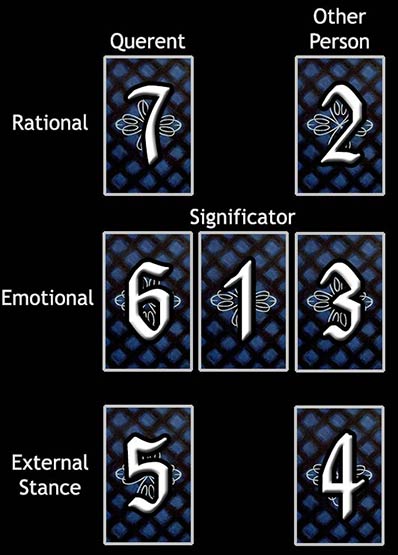Relationship Spread #1

Difficulty: Easy
This tarot spread is easy to read, like a convenient chart. In this spread, court cards generally indicate actual people with the same characteristics. Knights (or corresponding princes, but not kings) and queens are meant to represent actual men and women in this tarot spread. Look for patterns in the cards as always.
Card #1 is the overall significator of the relationship. The two columns on either side of the significator characterise each individual's role in the relationship. The relationship does not have to be romantic. In fact, it could be a relationship between a person and a group, or even how two groups relate.
The top row, cards #7 & #2, is about the conscious thoughts of each person, or what they think about the relationship and likewise how they view their partner.
The middle row, cards #6 & #3, reveals the way each individual feels about the other. Emotional awareness corresponds to a person's unconscious thoughts that run deep, affecting a person in ways he or she is not fully aware of.
The bottom row, cards #5 & #4, represents the way each person behaves, in other words the stance taken regarding the relationship. The way a person acts may be genuine, but sometimes people are phony and manipulative, so it is best to weigh this card against the other person's cards to determine how they match up.
Your Relationship #1 Reading
| You | Other Person | ||
| Thought |  The Fool |
 The Emperor |
|
| Emotion |  Temperance |
The Significator The Devil |
 The Wheel of Fortune |
| External Stance |  The Hanged Man |
 The Empress |

The Significator
The Devil
The colours black and white show the limits of a polarity, a disconnection, which cannot be outdone. The subconscious has no connection with the conscious. The burning fire points to the fact that the devil is linked with pain and torture.
The five-pointed star is upside down. The goat's horns are pointing downwards; classical symbols of the devil. The square oven symbolises the dependence on material things. Two clenched fists are chained together. Each can free the other whereby freeing itself, but only if it is brave enough to take the key from the fire. For this it has to open its hand.

The Querent's Thoughts
The Fool
The bright colours symbolise many possibilities. The Fool is holding the pilgrim's staff in his hand. Water and fish indicate openness and vivacity. The butterflies also indicate different ideas and a joy of living.
The golden yellow background gives the scene energy of life. One can see the tip of the Fool's cap. The cross, or rather the handle of the sword in the background, gives an awareness of danger, which is lurking along the path the Fool is going to take.

The Other Person's Thoughts
The Emperor
The picture has the effect of being rather poor and harsh. The blue colours represent coolness, but due to the red and yellow one can sense a certain energy, which also appears in Aries' head at the corner of the throne, connected astrologically with the Emperor.
The card's number four, which also represents the element earth, can be found in the house in the square of rocks and the crown also shows four spikes and four stones. Further symbols of the Emperor are an orb (symbol of world dominion) and a form of sceptre (symbol of materialism in life).

The Querent's Emotions
Temperance
The path through the underworld can be seen which eventually leads into light. The path is edged with lilies, the underworld flowers. The abstract archangel Michael is helping to find the right composition for the flow of energy, in other words is on the way through the subconscious (forgotten) to keep a minimal contact going with the conscious e.g., by transmission (documents...)

The Other Person's Emotions
The Wheel of Fortune
In the middle of the diagram three discs can be seen. I often use the number three in the descriptions as a basic universal number. The inner disc is blank. On the second disc we can make out the hourly Roman numerals. They appear anticlockwise to show that time's direction is relative.
The signs of the zodiac on the outer disc show a further meaning for the course of time. Around these discs or rings, as though one could present them how one liked, the four elements are arranged. They seem to be rotating and moving in a circle from light into dark and back again.

The Querent's External Stance
The Hanged Man
The sole of the foot is turned upwards, the world is turned upside down. This is what the picture shows. The beam and the rope are blue. Rationality, an attempt to consciously act, binds the hanged man. But here there also seems to be hope. Leaves are growing out of wood.
The colour yellow at the bottom of the picture stands for the light which the hanged man experiences when he manages to let himself fall. The wide path in the background leads to a dead-end against blue rocks. Walking back a bit one can find a narrow track which leads around the rocks back into the light. The violet background portrays the night sky. Normal vision is not carried any further.

The Other Person's External Stance
The Empress
The illustration represents growth, nature and fertility. One can see certain fruits, including two pomegranates (fertility). The ears of corn represent the Empress' secret crown. The apple is in the shape of a heart. The three fish in the water symbolise feelings and emotionalism, as well as the Empress' figure three.
The illusion of a bowl, in which the fruit is lying, can be connected with conception, the uterus and with pregnancy. The trees present slow growth. The Empress is holding her sceptre in her left hand.
